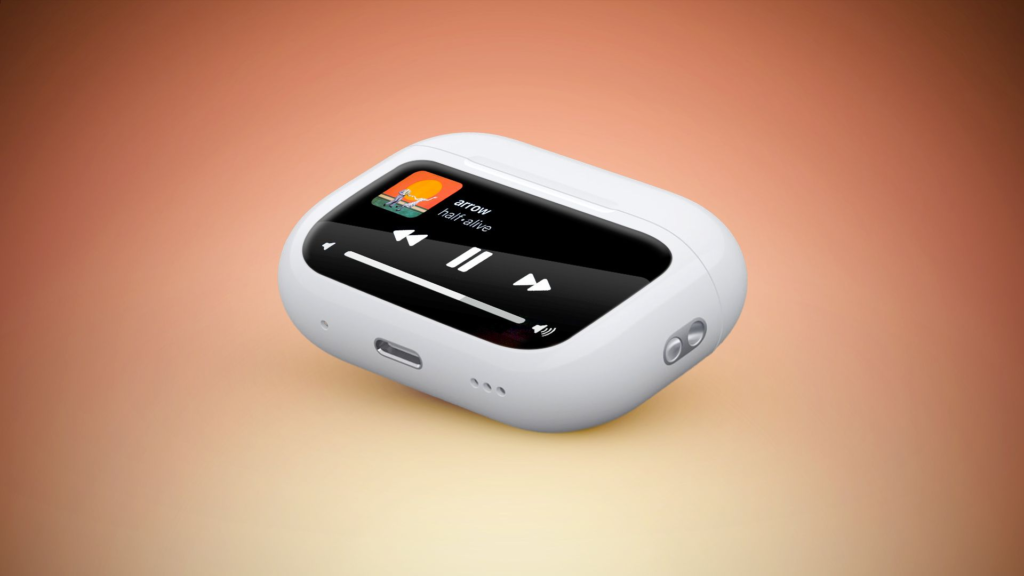Apple Patents Touchscreen AirPods Case
In a move that could redefine how we use wireless earbuds, Apple has patented a groundbreaking design for an AirPods case featuring a built-in touchscreen display.

This innovation, recently filed with the U.S. Patent and Trademark Office, hints at a future where AirPods users can control their music, check notifications, and even access apps like Maps or Weather directly from the case.
What Could a Touchscreen AirPods Case Offer?
According to the patent, users could tap or swipe to play, pause, or skip songs, adjust volume, or switch between noise-canceling modes without reaching for their iPhone. Need directions? The case might display a map. Curious about the forecast? A quick glance could show the weather.
Read this:
The patent also suggests Siri integration, allowing voice commands like “Hey Siri, play my workout playlist” to work seamlessly through the case. For users, this means more convenience and control, turning the case into a mini remote for your earbuds and beyond.
However, patents don’t always become products, so it’s uncertain if or when this touchscreen case will hit stores. Still, it’s a sign Apple is thinking big about making AirPods even more user-friendly.
The AirPods Story
Apple launched the first AirPods in December 2016, introducing the world to truly wireless earbuds.
With their sleek white design and seamless connection to iPhones, they quickly became a cultural phenomenon. The original model offered decent sound and a wireless charging case, but it was the 2019 AirPods 2 that added “Hey Siri” support and longer battery life.

The AirPods Pro, also released in 2019, brought noise cancellation and a snug in-ear fit, appealing to audiophiles and commuters alike.
In 2021, AirPods 3 introduced spatial audio, while the 2022 AirPods Pro 2 enhanced noise cancellation and added hearing health features, like at-home hearing tests. The 2024 AirPods 4, launched alongside the iPhone 16, offered active noise cancellation (ANC) without in-ear tips, catering to those who prefer a lighter fit.
Each release has refined the formula: better sound, smarter features, and tighter integration with Apple’s ecosystem. Today, AirPods are more than earbuds they’re a status symbol and a daily essential for millions.
Who’s Competing with AirPods?
Apple doesn’t dominate the wireless earbud market without competition. Brands like Samsung, Sony, Bose, and JBL offer strong alternatives
Samsung Galaxy Buds 3 Pro
Designed for Android users, these mimic AirPods’ stem design and deliver excellent sound with ANC. They’re a favorite for Samsung phone owners but lack Apple’s ecosystem perks.
Sony WF-1000XM5
Known for top-tier noise cancellation and rich audio, Sony’s buds appeal to audiophiles but are pricier and less intuitive for iPhone users.
Bose QuietComfort Earbuds
These shine in noise cancellation and comfort, rivaling AirPods Pro for travelers or office workers, though they’re bulkier.
JBL Live Beam 3
JBL’s latest earbuds include a touchscreen case, a feature Apple’s patent seems to echo. They’re affordable and versatile but don’t match AirPods’ polish.
While these brands compete on sound quality and features, Apple’s edge lies in its seamless pairing with iPhones, iPads, and Macs, making AirPods the go-to for Apple loyalists.

AirPods have carved out a massive share of the global hearables market, holding about 19% worldwide and 34.4% in the U.S. headphones segment.
They’re especially popular among younger users—think Gen Z and Millennials—who value convenience and brand appeal. Students, professionals, and fitness enthusiasts use AirPods for everything from Zoom calls to workouts to binge-listening podcasts.
Men and women alike adopt them, with no clear gender skew, and they’re most common in urban areas.
Demographically, AirPods users tend to be tech-savvy, trend-conscious, and often own multiple Apple devices. They’re not just for the wealthy—while AirPods Pro ($249) and AirPods Max ($549) are premium, the base AirPods 4 ($129) broaden the appeal.
AirPods and Apple’s Bottom Line
AirPods are a financial powerhouse for Apple. In 2023, they generated roughly $18 billion in revenue, outpacing companies like Spotify or Nintendo.
Experts estimate AirPods account for 5-7% of Apple’s total revenue, a remarkable feat for a product that’s just one part of Apple’s lineup, alongside iPhones, iPads, and Macs. In 2024, Apple was projected to sell 10 million units, potentially pushing revenue to $15-20 billion. This growth comes as Apple continues to innovate, with rumors of AirPods Pro 3 slated for 2025.
If Apple’s touchscreen AirPods case becomes reality, it could make an already popular product even more indispensable. By blending convenience, style, and smart features, AirPods have reshaped how we listen—and this patent suggests they’re not slowing down.
Whether you’re a die-hard Apple fan or just curious, the future of AirPods looks like it’s worth hearing about.
Note: Patents don’t guarantee products, and competitor details are based on current market trends.


![An ambulance is parked at the site of the Lapu Lapu event in Vancouver [Jennifer Gauthier/Reuters]](https://worldinfo.news/wp-content/uploads/2025/04/Car-Crashes-into-Vancouver-Festival-Kills-Several-554x346.webp) Car Crashes into Vancouver Festival Kills Several
Car Crashes into Vancouver Festival Kills Several  Trump Meets Zelensky, Questions Putin’s Peace Intentions
Trump Meets Zelensky, Questions Putin’s Peace Intentions  Kashmir Tensions Rise After Attack and Border Clashes
Kashmir Tensions Rise After Attack and Border Clashes  Jhelum Water Release Triggers Pakistan
Jhelum Water Release Triggers Pakistan  Barcelona Clinches Copa del Rey Over Real Madrid
Barcelona Clinches Copa del Rey Over Real Madrid  UK Social Media Giants Face £60000 Fines
UK Social Media Giants Face £60000 Fines